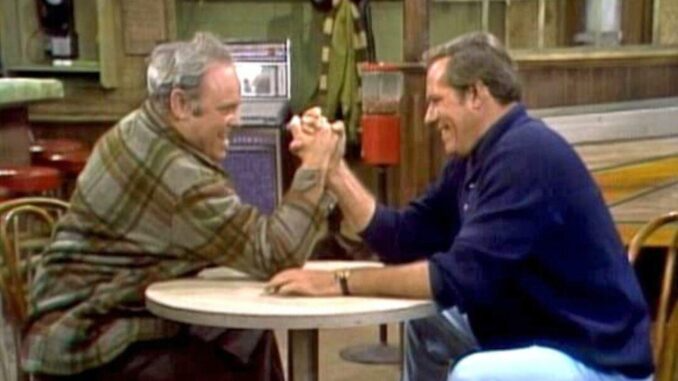
In 1971, All in the Family broke barriers by featuring one of TV’s first openly gay characters—challenging Archie Bunker’s worldview and changing sitcom history forever.
The Historic Moment All in the Family Introduced a Gay Character—and Shocked America
In the early 1970s, American television was still playing it safe. Sitcoms were known for lighthearted stories and traditional family dynamics. But in 1971, All in the Family changed everything—again. In a bold and unprecedented move, the show introduced an openly gay character, turning a regular episode into a cultural milestone.
A Scene That Changed Television
The episode, titled “Judging Books by Covers,” featured Archie Bunker confidently assuming that one of his visiting friends, Steve, was the perfect example of masculinity—tough, athletic, and conservative. But the real twist came when Archie learned that Steve was actually gay. The revelation didn’t just stun Archie—it stunned an entire generation of viewers.
The brilliance of the episode wasn’t in the twist itself, but in how it challenged stereotypes. Steve didn’t fit any of the clichés often portrayed in media at the time. Instead, All in the Family forced its characters—and its audience—to confront their own assumptions.
Confronting Prejudice With Humor and Honesty
Archie Bunker, played by Carroll O’Connor, was the perfect lens for viewers to examine their own biases. His knee-jerk reactions and stubborn opinions reflected attitudes that many held but rarely saw challenged on TV. When his assumptions were turned upside down, the comedy hit hard—and so did the message.
By using humor to tackle homophobia head-on, the show opened the door to more inclusive storytelling. This episode didn’t preach—it portrayed. And that’s what made it so powerful.
A Risk That Paid Off
At a time when LGBTQ+ representation on television was almost nonexistent, this episode was revolutionary. It pushed the boundaries of what a sitcom could say, and how it could say it. Rather than relegating gay characters to stereotypes or punchlines, All in the Family gave them dignity, realism, and purpose.
Critics praised the episode for its bravery and wit, and audiences responded with curiosity, debate, and—eventually—acceptance. What once felt shocking soon became groundbreaking.
The Legacy of Steve’s Character
Looking back, Steve’s role in All in the Family was more than just a plot device—it was a turning point. It paved the way for future LGBTQ+ representation on screen and proved that audiences were ready for honest, authentic stories.
Shows like Will & Grace, Modern Family, and Pose all owe a debt to the risks that All in the Family was willing to take over 50 years ago.
Why It Still Matters
In an era where representation remains a vital issue, this 1971 episode stands as a reminder of how far we’ve come—and how far we still have to go. It’s proof that television can do more than entertain. It can challenge, disrupt, and inspire change.
With just one character and one unexpected twist, All in the Family made TV history—and helped move society forward, one laugh at a time.
